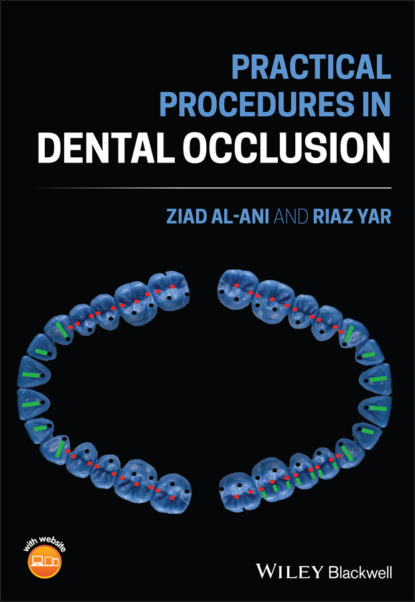About the Book The subject of occlusion has traditionally been very difficult to learn, understand and manage. As a result, an unwanted mystique has been built around it that has intimidated a large part of the dental profession. It is now more important than ever that dental practitioners familiarise themselves with a subject that so intimately affects their daily professional lives. Restorative treatment outcome is highly dependent on the occlusion of the restoration when the treatment is complete and therefore sound up‐to‐date knowledge of all evidence‐based aspects of this commonly encountered condition is essential. General practitioners usually have very limited practical clinical experience in occlusion and most of the books available for them are theory‐based resources. This book aims to enable readers to gain a solid foundation of knowledge of occlusion, by providing practical, learnable, usable information and techniques which are demonstrated in a practical and easy‐to‐understand style. The intention is to explain current evidence‐based practical concepts in the field of dental occlusion so that they can be reflected in the reader's clinical practice. The book contains a series of everyday clinical situations in occlusion, that may be encountered in general practice, to help readers understand and engage with the information and to promote effective clinical management. It aims to provide practical guidance to what is required to optimise restorative treatment outcomes, including occlusion, in simple and advanced restorative care. The book also promotes learning as a dynamic process of active involvement. It encourages valuation by self‐assessment with questions at the end of the book. Chapter 1 – Terminology It is important we address terminology right at the start to reduce the confusion that has been created throughout the history of occlusion. As a source, Glossary of Prosthodontic Terms 2017 edition is used throughout the book. Chapter 2 – Neuroanatomy – Why is It Important? This chapter will address neuromuscular philosophies and introduce the neurolink between all systems from the periodontal mechanoreceptors on teeth through to central pattern generators in the pons and muscles and temporomandibular harmony. Chapter 3 – What's of Use to Me in Practice? Armamentarium, Equipment and Techniques This is a ‘how‐to’ chapter. It is important for the clinician to know the equipment and techniques used in occlusal examination, registration and record. This chapter also discusses facebow, articulators and how to make a stabilisation splint. Chapter 4 – I Don't Know What I Am Recording Where are the True Contacts? This chapter illustrates a classic problem most of the practitioners face when recording occlusal contacts using different articulating papers. It will highlight the following: morphology and type of occlusal contacts in class 1, class 2 and class 3 relationships the importance of selecting the correct size of articulating papers the appropriate techniques in recording occlusal contacts how to properly mark shiny occlusal surfaces. Chapter 5 – The Crown is High This clinical scenario will highlight the possible factors which may contribute to this situation (a high crown). It discussed the importance of accurate opposing alginate impression and mounting of the casts. The laboratory handling of the cast and the provisional crown will be covered. Chapter 6 – My Bite Feels Different Using a clinical scenario of a change of patient bite following fitting of an indirect restoration, this chapter will mainly focus on the importance of adopting the conformative approach in restorative dentistry. The possibility of introducing iatrogenic changes to a patient's bite is quite real and can have immediate consequences. Avoidance of the problem is the best approach but to do this, you must be aware of the potential pitfalls in restorative care. Chapter 7 – My Front Tooth Filling Keeps Fracturing This clinical scenario of a fractured upper central incisor composite restoration will highlight the importance of checking premature contacts in centric relation and dynamic occlusion. Chapter 8 – TMD and Occlusion – Is There a Link? Opinion regarding the importance of occlusion as an aetiological factor in the development of TMDs has shifted between it being the main causative factor and there being no correlation at all. This chapter will discuss this controversy and provides the reader with findings from contemporary literature. Chapter 9 – How Would I Adjust a High Occlusal Contact? This chapter will explain the proper techniques which should be adopted when adjusting the occlusal contacts and interferences by the dentist. Chapter 10 – How Would I Ensure a Good Occlusion on Posterior Composite Restorations? This chapter will illustrate the concepts and practical steps of achieving occlusal surfaces which provide proper reconstruction of natural morphology. It will highlight the following aspects: conforming to existing guidance in restored teeth creating departure clearance spaces the importance of the location of the occlusal contact. Chapter 11 – My Front Teeth Feel Loose and Are Moving This chapter will discuss occlusal trauma from functional or parafunctional forces. Lack of freedom in centric and the effect of RCP–ICP slide on anterior teeth will be also covered. Chapter 12 – Canine Guidance or Group Function? This has been an ongoing debate over many years with discussions on which lateral‐based occlusal scheme is the best for the patient. This chapter will discuss the rationale behind both and how to achieve them clinically. Chapter 13 – Replacing Missing Teeth – Abutment is Involved with Guidance This clinical scenario will highlight the flowing points: checking the guidance prior to commencing treatment conforming to the guidance by selecting a treatment plan which avoids changing it. Chapter 14 – The Space is Lost! Loss of Occlusal Space Following Crown Prep This chapter will discuss the significant concepts which need to be understood and planned when considering restoration of a tooth involved in the centric relation/retruded contact position. How to manage when the space is suddenly lost during crown preparation on a tooth that is the last in the arch. Chapter 15 – My Front Teeth Are Worn Management of tooth surface loss is a complex treatment but some straightforward rules will help in diagnosis of the cause, monitoring of the situation
